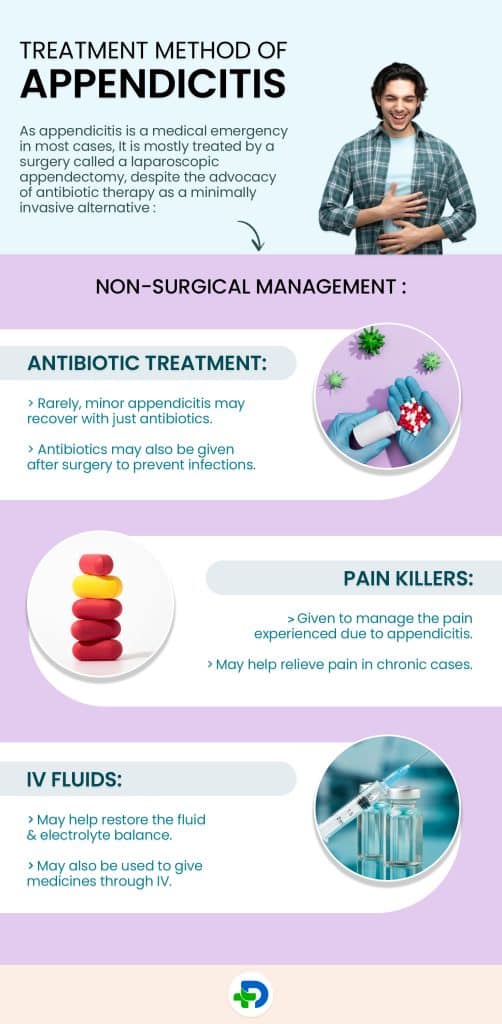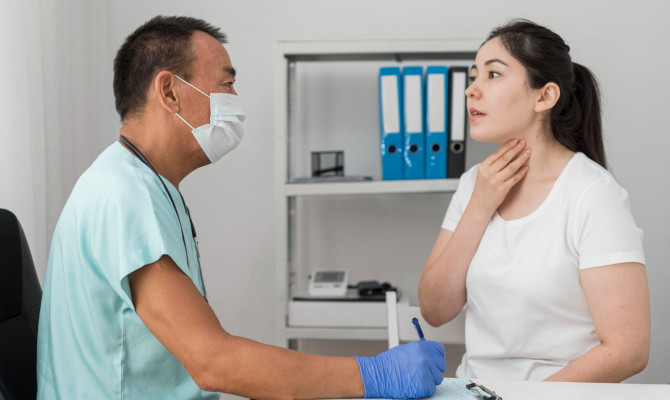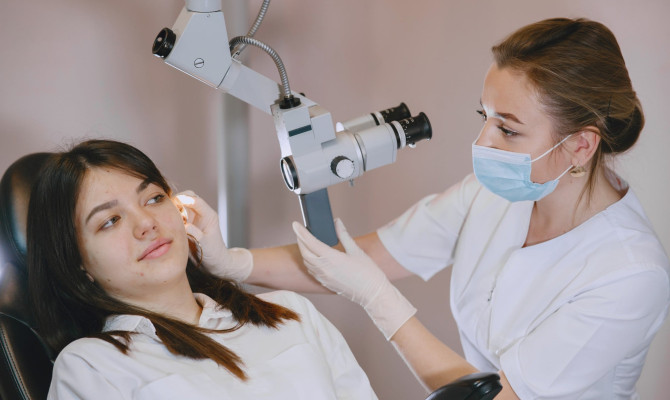Appendicitis : Risk and Management

- Appendicitis
- 14 Aug 2023
Overview
Appendicitis
Appendicitis may be the cause of pain that starts close to the navel and spreads to the lower right side of the abdomen. When the infection progresses, the pain frequently gets worse until it is finally intolerable.
On the bottom right side of the abdomen, next to the large intestine,the appendix is a tiny, finger-shaped structure. 1Overview | Researched based study from Nih.gov
The most frequent reason for acute abdominal discomfort that necessitates surgery in the United States is appendicitis. An appendicitis attack occurs in 5 to 9 out of every 100 people. 2Overview| Researched based study from Nih.gov Within your clogged appendix, bacteria can proliferate and grow. The swelling and pus production may cause unpleasant pressure in the belly and may restrict blood flow. If the appendix is untreated and ruptures, it can be harmful and even fatal if they flood the abdominal cavity.

Classification
Classification of Appendicitis
Based on the onset, there are two types, as follows:
Acute appendicitis (AA)
- Pain often develops suddenly and gets severe quickly.
- Young individuals from 10 to 30 are the most frequently affected. 3Classification of Appendicitis | Researched based study from Nih.gov
- May require immediate medical attention or surgery.
- Is frequently the trigger for individuals to seek the emergency room.
- Infected appendix may rupture and lead to deadly complications, if not treated immediately.
Chronic appendicitis
- Less common and less severe type.
- Only seen in 1.5% of people who have already experienced acute appendicitis.
- Lasts longer than 1-2 days and often extends to weeks, months, or even years.
- Diagnosing this kind of appendicitis can be difficult.
- Usually not a medical emergency. 4Classification of appendicitis | Researched based study from Sagepub.com
Vulnerability
Who is vulnerable to appendicitis?
Anyone can get appendicitis. Nonetheless, some people may have a greater tendency than others to get affected. There is a chance that the following risk factors will contribute to the condition:
- Age- although it can affect anyone at any time, it most frequently affects people from 10 to 30 years of age. 5Vulnerability to appendicitis| Researched based study from nih.gov
- Gender- Men are affected more frequently than women.
- Hereditary- those with a family history of appendicitis are more likely to get it.
- Pregnant women- Acute appendicitis in pregnant women is the most frequent emergency, unrelated to pregnancy issues. 0.04 to 0.2% of expectant women are thought to be affected.
Causes
Causes of appendicitis
The exact cause is often unclear. Appendicitis is caused by an obstruction or blockage of part of the appendix, which can happen for a number of reasons
- Stones- Appendix stone.
- Cancer of the appendix- carcinoid tumors or adenocarcinoma.
- Constipation- Hardened stools may block the appendix’s opening.
- Infection on digestive tract- Enlarged walls of the appendix.
- Irritable bowel syndrome (IBS).
- Ingestion of a foreign body.
- Appendix infection: Pus-filled appendix swelling.
- Exaggerated lymphoid follicles.
- Serious injury to the abdomen.
- Worms in the intestines.
Symptoms
Symptoms of Appendicitis
There could be some such symptoms very common among appendicitis patients, like
- Pain that starts close to the belly button, descends, and moves to the right.
- Severe and sudden abdominal pain that gets worse quickly and may even startle you up from sleep.
- Pain that aggravates with movement, deep breathing, coughing, or sneezing.
- May have a fever of 99-102 F.
Following are some more, less typical signs of appendicitis:
- Pain during urination.
- Really bad cramps.
- Diarrhea or constipation.
- Nausea or vomiting.
- Lack of hunger.
- Abdominal swelling.
- Feeling sick.
- The inability to expel gas.
- A sense that suffering might be eased by pooping.
- Greater frequency or urgency in the urination.
- Some kids could not exhibit any of these common symptoms. 6symptoms of appendicitis | Researched based study from wiley.com
Prevention
Measures to prevent appendicitis
Appendicitis cannot be completely avoided. But, consuming a diet high in fiber may help reduce the risk of getting it.
- Appendicitis is less frequent in people who consume high-fiber diets.
- Food that contains high fiber content like fruits, vegetables, legumes, whole grains, etc. may help.
- Daily fiber supplement may also be recommended.
- Regular exercise.
- Good amount of fluid intake.
Diagnosis
Diagnosis of appendicitis
Before beginning a physical examination, the doctor may inquire about the patient’s symptoms, family history, past medical history, etc. They might also request the following tests or scans:
Physical examination
- To check for rigidity or swelling in the bottom right portion of the belly.
- A pelvic exam in females detects any ovarian cysts, pelvic inflammatory disease, or other disorders.
- A digital rectal examination may be done.
Blood test
- A complete blood count (CBC), to look for signs of infections.
- A C-reactive protein test may be done to rule out similar symptoms caused by infections of other abdominal organs, autoimmune disorders, or any other longstanding illness.
Urine test
- It is done to rule out other infections like a bladder infection, and urinary tract infection (UTI), which may show similar symptoms.
Pregnancy test
- Done to rule out ectopic pregnancy, which also shows similar symptoms.
- Ectopic pregnancy is also a medical emergency.
- May use blood or urine to test for pregnancy.
- Pelvis or transvaginal ultrasound may also be used.
Chest x-ray
- Recommended to rule out pneumonia in the lower right lung lobe, which could also show similar symptoms to appendicitis.
Computed tomography (CT)
- Taken for more accurate images of the abdomen in cross-sections.
- Before getting a CT scan, women of reproductive age should undergo a pregnancy test to avoid radiation exposure.
Magnetic resonance imaging (MRI)
- Can help get detailed pictures of the abdominal organs using radio waves and magnets.
- To rule out other abdominal illnesses like inflammatory bowel illness, intestinal obstruction, fecal impaction, Crohn’s disease, ulcerative colitis, and abdominal abscess.
- A computed tomography (CT) scan can be replaced with an MRI scan by doctors as a secure, trustworthy alternative.
Ultrasound
- It displays images of the organs using high-frequency sound waves.
- Performed as an initial imaging test to rule out appendicitis in newborns, kids, teenagers, and pregnant women, as one need not worry about radiation exposure.
Laparoscopy
- If the doctor is still unsure of the diagnosis, they may use a laparoscopy to check appendix and pelvic organs.
Complications
Complications of appendicitis
Untreated appendicitis can lead to the appendix rupturing and the following potentially deadly complications:
Peritonitis
- The peritoneum, or lining of the belly, may become infected with bacteria if the appendix ruptures.
- Peritonitis can result in long-term issues, may harm the internal organs and even be fatal if it is not treated right away.
- The most common treatments for peritonitis include antibiotics and appendix removal surgeries.
Abscess
- An appendix burst can occasionally cause a painful pus-filled pocket called an abscess to develop.
- The body’s attempt to combat the infection is shown by this pus accumulation.
- Antibiotics are required to treat the infection, and the abscess needs to be drained under anesthesia, with the help of an ultrasonography or CT scan to direct the treatment.
- If an abscess is discovered during surgery, the region is thoroughly cleaned and an antibiotic course is administered.
- An abscess can occasionally develop following appendix removal surgery also.
Sepsis
- In some instances, germs from an abscess that has ruptured may spread to other organs of the body through circulation. Sepsis is the name for this incredibly dangerous complication.
- Sepsis may show signs like high or low body temperature, confusion, extreme drowsiness, and shortness of breath.
- One in three patients who have sepsis die as a result of their medical condition. Should call for emergency help immediately if suspected.
Treatment

Treatment methods
As appendicitis is a medical emergency in most cases, it is mostly treated by a surgery called a laparoscopic appendectomy, despite the advocacy of antibiotic therapy as a minimally invasive alternative 7Treatment of appendicitis | Researched based study from nih.gov ,8Treatment of Appendicitis | Researched based study from Nih.gov
Non-surgical management:
Antibiotic treatment:
- Rarely, minor appendicitis may recover with just antibiotics.
- Nonetheless, in the majority of cases, the recommended treatment plan for appendicitis will involve taking antibiotics before having the inflamed appendix surgically removed.
- Antibiotics may also be given after surgery to prevent infections.
Pain killers:
- Given to manage the pain experienced due to appendicitis.
- May help relieve pain in chronic cases.
- Help relieve pain in acute cases before surgery.
- Also prescribed after surgery to manage pain.
IV fluids:
- May help restore the fluid and electrolyte balance.
- May also be used to give medicines through IV
Surgery
Surgical options for management
With a lifetime risk of 8.6% for men and 6.7% for women, acute appendicitis is the most frequent reason for emergency surgery worldwide 9surgery of appendicitis | Researched based study from nih.gov 10Surgery of appendicitis| Researched based study from sciencedirect.com .
In order to avoid the possibility of the appendix rupturing, if appendicitis is suspected, excision of the appendix is often indicated. This implies that even if the appendix is ultimately determined to be normal, some patients will still have it removed.
Drainage of the abscess:
- If the abscess has not ruptured, they can have it drained with a needle or through surgery before having the infected appendix removed.
Laparoscopy/ keyhole surgery/ Minimally invasive surgery (MIS)
- The appendix is removed through tiny abdominal incisions using tiny instruments that respond to the movements of the surgeon’s hands.
- The abdomen’s interior is magnified for the surgeon to see on a monitor.
- There is little blood loss and fewer scars, and the recovery is also quicker when compared to open surgery.
Open surgery/ laparotomy
- The lower right portion of the abdomen will be cut with a single, bigger incision by the surgeon through which the appendix is removed.
- Also allows for the cleaning of the area inside the abdominal cavity, in case of an appendix rupture or an abscess formation or in case of peritonitis, where the inner lining of the abdomen is widely infected.
- May also be used to remove abdominal tumors if present.
- Recommended for those who have undergone open abdominal surgery in the past or if the patient is a pregnant woman in the third trimester.
- The physician will administer intravenous antibiotics to the patient after open surgery to prevent infections.
Post-surgery
Post-surgical care and complications
A recovery plan should be discussed with the health care team post-surgery, which may include the following:
- Follow the prescriptions for antibiotics and painkillers to help recuperate from having the appendix removed through surgery.
- Include a diet with high fiber content.
- Consider taking a fiber supplement if you have constipation.
- Avoid strenuous activity until the doctor says it is okay to do so.
- Rest frequently.
- Keep fluid intake high.
- Every day, take a stroll.
- Maintain the surgical incision sites clean and dry.
Surgical complications
Appendix removal is one of the procedures that are most frequently performed. Nonetheless, there are hazards associated with surgery of all kinds, such as:
- An infection at the site of surgery.
- Hematomas- bleeding under the skin.
- Fistula- an irregular tube that may develop between the stomach or intestine and the skin.
- Scarring- both surgical procedures result in some scarring at the sites of incisions.
- Abscess- An accumulation of pus- in extremely rare circumstances, an infection brought on by the rupture of the appendix might result in an abscess following surgery.
- Hernia at the open incision site or any of the keyhole surgical incision sites.
- Ileus- a condition characterized by improper bowel function.
- Small intestine blockage
- Allergic response to general anesthesia, or pneumonia from breathing stomach contents. However grave issues like this are quite uncommon.
Takeaway
Key takeaways
Appendicitis is a dangerous condition that requires immediate medical intervention. Avoid using heating pads, laxatives, or any other painkillers when appendicitis is suspected to be the cause of the symptoms, as they might cause the appendix to burst. An appendix rupture results in a severe infection that may be fatal. Sometimes treating appendicitis with antibiotics alone is sufficient in mild cases. A minimally invasive laparoscopic procedure can help you heal more quickly if you require surgery. The dangers connected with surgery and antibiotics are significantly less frequent and typically less severe than the complications associated with untreated appendicitis. The appendix almost usually requires removal straight away, and anyone can survive just well without their appendix.
Any feedback on this article?
 This Articles content was accurate
This Articles content was accurate Very Informative Article
Very Informative Article I have a question or a comment
I have a question or a comment
 This article contains inaccurate content
This article contains inaccurate content This article was not helpful
This article was not helpful I have a question or a comment
I have a question or a comment
We appreciate your helpful feedback!
Checkout our social pages
References
-
National Institutes of Health
Should ambulatory appendectomy become the standard treatment for acute appendicitis? | Overview
-
National Institutes of Health
Appendicitis | Overview
-
National Institutes of Health
Diagnosis and treatment of acute appendicitis: 2020 update of the WSES Jerusalem guidelines | Classification
-
SAGE Journals
Chronic appendicitis: uncommon cause of chronic abdominal pain | Classification
-
National Institutes of Health
Definition & Facts for Appendicitis | Vulnerability
-
Wiley Online Library
Atypical Clinical Features of Pediatric Appendicitis | Symptoms
-
National Institutes of Health
Randomized clinical trial of antibiotic therapy versus appendicectomy as primary treatment of acute appendicitis in unselected patients | Treatment
-
National Institutes of Health
2013 WSES guidelines for management of intra-abdominal infections | Treatment
-
National Institutes of Health
A new adult appendicitis score improves diagnostic accuracy of acute appendicitis--a prospective study | Surgery
-
Science Direct
Ambulatory management of gastrointestinal emergencies: What are the current literature data? | Surgery


































